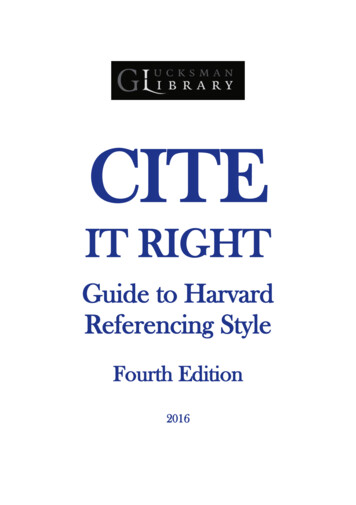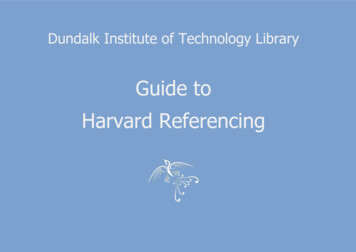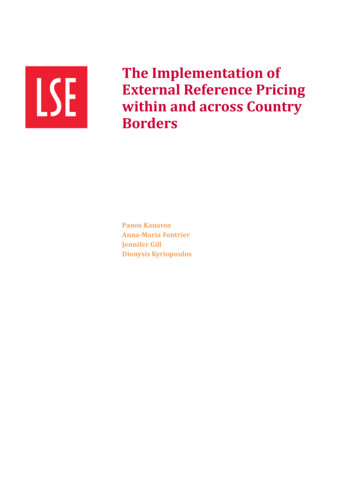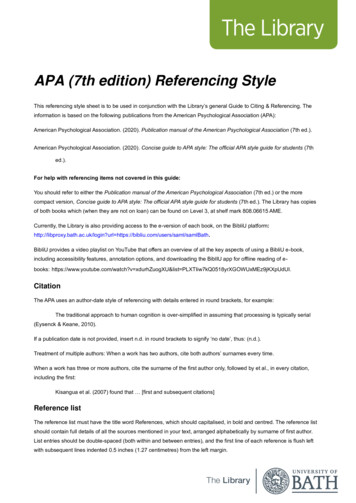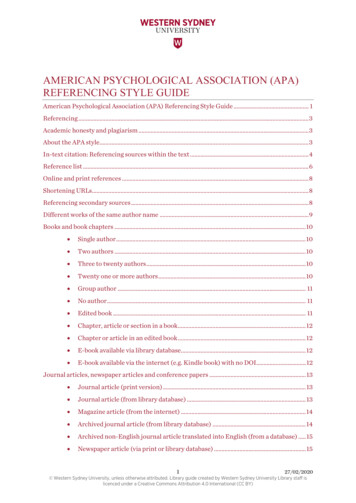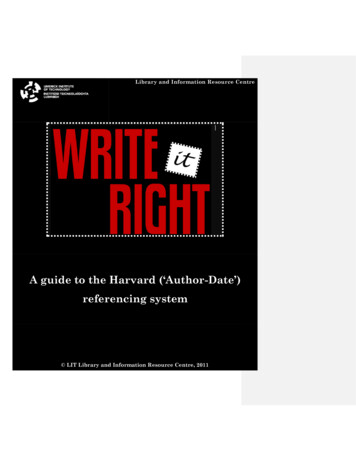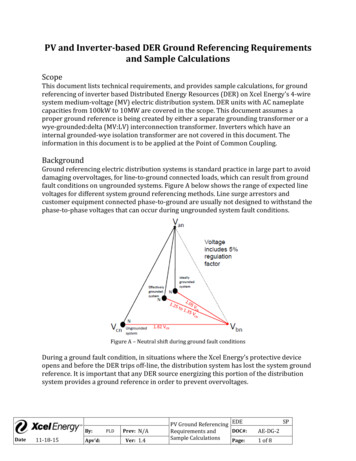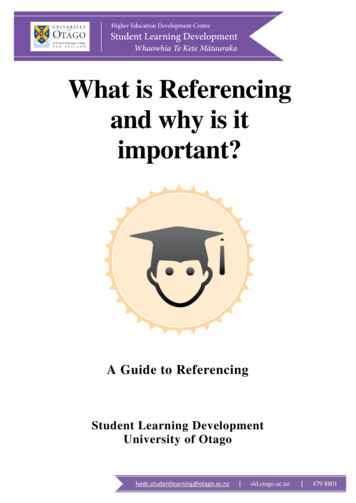
Transcription
What is Referencingand why is itimportant?A Guide to ReferencingStudent Learning DevelopmentUniversity of Otagohedc.studentlearning@otago.ac.nz sld.otago.ac.nz 479 8801
This booklet is an introduction to some of the skills and strategies that will helpyou successfully complete your studies at Otago.Version 2.0 Revised 2017hedc.studentlearning@otago.ac.nz sld.otago.ac.nz 479 8801
To help show academic understanding and rigor you need to place yourwork within a framework or context that is relevant to the topic you arediscussing. This context might, for example, include reference to data(e.g., the latest employment data from Statistics New Zealand), or anexact quote, or a summary of what other people have had to say about thetopic. There are many possible resources that you may refer to dependingon your area of study.As you develop your own ideas and arguments and use others’ work tosupport or contrast your views it is really important that you identifyclearly which ideas are yours and which ideas or work belong to anotherperson or source. You should always acknowledge any ideas and workthat were not originally your own by providing a reference to the sourceof that information. Doing so is essential to avoid plagiarism.In academic work, referencing is the appropriate acknowledgement of:Ideas and work that originate from another personInformation that you have included in your work that comes from someother source (which is not common knowledge or widely accepted).The terms cite and refer (or citation and reference) are often used tomean the same thing since to cite a piece of work is to provide areference to its source.Referencing is important because it: Helps show that you have been thorough and careful (or rigorous)in your academic work Indicates what material is the work of another person or is fromanother source Indicates what material is your original work since you haveprovided a citation for work that is not your own Allows the reader to refer back to any external material (i.e., notyour own) that you have stated or discussed Provides the reader with an indication of the quality and authorityof the material you are referencing (e.g., published article in arespected journal, unpublished opinion piece on a popular onlinewebsite) Of course the relevance and importance of material isdependent on your topic Lets the reader see if you have included up-to-date work, seminal(early and influential) work, and material central to your researchtopichedc.studentlearning@otago.ac.nz sld.otago.ac.nz 479 8801
What do I need to reference?You should always provide a reference to all material that you: Quote Paraphrase SummariseYou should also provide a reference to any: Ideas you are using in your work that originate with someone else Data or other information that is not common knowledge, iscontroversial, or is specialised knowledge (e.g., you don’t need toprovide a reference to the fact that the kiwi is the national bird ofNew Zealand, but if you were to state that the kiwi population isdeclining at a rate of 4-5% per year, then a reference is required)Note that where the source of your information came from (e.g., socialmedia, TED talk, newspaper, journal, government report) does notdetermine whether or not you need to provide a reference. Nor does itmatter whether the source of your information has been officiallypublished (although this may have an impact on the credibility andauthority of the material).Referencing/Citation stylesThere are a great many different styles and you should follow thereferencing style required for your particular assignment, or as set out byyour lecturer or department, and confirm this for each assignment. Howyou format your reference depends upon the reference or citation styleyou use e.g., Vancouver (a numbered system), APA (an author-datesystem), Chicago (a notes-bibliography system).In all referencing systems a short reference, called the in-text citation, isappropriately placed within the body of the text to provide a key to thefull bibliographic details that will follow later in your work in thefootnotes, endnotes, reference list or bibliography. (The format and termsused depend on the citation style.)The terms reference list and bibliography are sometimes used to meanthe same thing, that is, the complete list of references or bibliographicdetails for the sources you have cited. However, bibliography can beused more broadly to describe a list of relevant, influential, and relatedhedc.studentlearning@otago.ac.nz sld.otago.ac.nz 479 8801
sources, which may also include work that you did not directly cite.Vancouver example (journal article, one author):In-text citationMcLean states that it is probable that the chicken came before the egg[1].References1 McLean, B. The chicken came before the egg. Journal of Tall Tales2025:16: 66-68. doi: 00:1122334455APA example (journal article, one author):In-text citation option 1.A recent study by McLean (2025) discussed the issue of which camefirst, the chicken or the egg.In-text citation option 2.A recent study discussed the issue of which came first, the chicken or theegg (McLean, 2025).ReferencesMcLean, B. (2025). The chicken came before the egg. Journal of TallTales, 16(4), 66-68. doi: 00:1122334455Chicago example (journal article, one author):In-text citationMcLean states that it is probable that the chicken came before the egg. 1FootnotesMcLean, B. “The chicken came before the egg.” Journal of Tall Tales16, no. 4 (2025): 66.1hedc.studentlearning@otago.ac.nz sld.otago.ac.nz 479 8801
BibliographyMcLean, B. “The chicken came before the egg.” Journal of Tall Tales 16,no. 4 (2025): 66-68. doi: 00:1122334455Citation SoftwareIf you are going to write reports and assignments that will require anumber of references then it can be a good idea to use citation software tohelp you manage those references. There are a number of differentcitation programs; some are free and others cost money to use. There are a variety of reference management software toolsavailable. Use the University of Otago Library’s Managingreferences guide to find out which will suit you besthttp://otago.libguides.com/managingreferences EndNote is a widely used program and is supported by the Libraryand ITS. It is available for Mac and Windows platforms. EndNoteis available free to all students via the Student desktopwww.otago.ac.nz/studentdesktop. It is also possible to purchaseEndnote for your own computer through ITS for a small fee index.html). ITStraining run courses using EndNote otago030141.html).Your Subject Librarian can also help you with Endnote. Zotero is free to use (https://www.zotero.org Mendeley is free to use (https://www.mendeley.com) If you are using LaTex for your documents then you will haveBibTex as your citation management software. You may findhttp://www.bibsonomy.org/ useful for recording and sharingreferencesRelated ResourcesSLD booklet Quoting, paraphrasing & summarising (or how to avoidplagiarising) available online c.studentlearning@otago.ac.nz sld.otago.ac.nz 479 8801
number of references then it can be a good idea to use citation software to help you manage those references. There are a number of different citation programs; some are free and others cost money to use. There are a variety of reference management software tools available. Use the University of Otago Library's Managing
